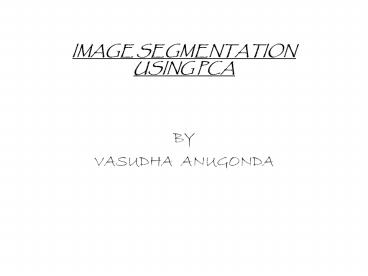IMAGE SEGMENTATION USING PCA - PowerPoint PPT Presentation
1 / 35
Title:
IMAGE SEGMENTATION USING PCA
Description:
BACKGROUND MATHEMATICS. The sub images are stored as stack one behind the other. ... 4)The re-synthesis of textures using gaussian distribution can be used as an ... – PowerPoint PPT presentation
Number of Views:215
Avg rating:3.0/5.0
Title: IMAGE SEGMENTATION USING PCA
1
IMAGE SEGMENTATIONUSING PCA
- BY
- VASUDHA ANUGONDA
2
Image Segmentation
- To distinguish objects in an image
- Two types
- 1) Edge based
- 2) Region based
- We are using region based segmentation
3
Technique used
- Four steps
- The image is split into 3x3 blocks
- 2) PCA is applied on the set of the blocks
- 3) The blocks are clustered
- The image is reconstructed based on the clusters
represented by the blocks
4
(No Transcript)
5
- Step 1
- image is split into sliding blocks of 3 x 3 such
that each pixel is represented by its
8-neighborhood.
6
- Step 2
- PRINCIPAL COMPONENT ANALYSIS
7
PCA is, at its essence, a rotation and scalng of
a data set. The rotation is selected so that
the axes are aligned with the directions of
greatest variation in the data set. The
scaling is selected so that distances along each
axis are comparable in a statistical sense.
Rotation and scaling are linear operations, so
the PCA transformation maintains all linear
relationships.
8
Principal component analysis of a two-dimensional
data cloud. The line shown is the direction of
the first principal component, which gives an
optimal linear reduction of dimension from 2 to
1 dimensions.
9
(No Transcript)
10
(No Transcript)
11
- One way to think about PCA is that it generates a
set of directions, or vectors in the data space.
The first vector shows you the direction of
greatest variation in the data set the second
vector shows the next direction of greatest
variation, and so on. The amount of variation
represented by each subsequent vector decreases
monotonically.
12
BACKGROUND MATHEMATICS
- The sub images are stored as stack one behind the
other. - The relation among all the pixels of the blocks
are calculated - It is stored in covariance matrix
- The eigen vectors of the covariance matrix are
found .
13
- The resulting matrix T is already the transform
that concentrates the energy of an average n n
texture block in the best possible manner. Each
texture block in the original image can now be
transformed using that transform.
14
- Step 3
- This matrix is given to a clustering algorithm
such as k-means which gives a label to each
block. The block is colored according the label - Step 4
- A new matrix is constructed with these blocks
15
ImprovisationTexture Re-synthesis
- Instead of using all the coefficients of the
eigenvectors we use a different method to
represent them in an easier way - For each of these nn coefficients the average
value and variance must now be computed.
16
17
- An analysis of the statistical distribution of
the coefficients reveals that following a
Gaussian distribution all are scattered around a
mean value. - For each of the coefficients a Gaussian
distributed random number with its mean value and
variance is generated. - Using the inverse transform T-1 such a random
vector can then be transformed back into the
spatial domain.
18
- Original image
19
20
(No Transcript)
21
22
23
24
25
(No Transcript)
26
(No Transcript)
27
(No Transcript)
28
(No Transcript)
29
- PCA fails sometimes because of the texture
similarity , but difference in color values
30
(No Transcript)
31
(No Transcript)
32
Observations
- PCA performs image segmentation based on the
patterns of values in the image. This pattern
represents texture. - This pattern can also represent color , hence
this segmentation can be used for segmentation
based on color - 3) Depends on the clustering algorithm used
33
- 4)The re-synthesis of textures using gaussian
distribution can be used as an image enhancement
technique. - 5) Using texture re-synthesis and PCA together
produces a good segmented image. - 6) Same computation required .
- 7)This can also be used to transmit images in a
compact form.
34
Applications
- Image segmentation
- Object detection
- Image enhancement
- Image compression
- Reading of satellite and radar images
35
References
- http//faculty.washington.edu/kayee/pca/pca.pdf
- http//www.informatik.uni-mannheim.de/pi4/publicat
ions/library/Haenselmann2002a.pdf - http//www.cs.otago.ac.nz/cosc453/student_tutorial
s/principal_components.pdf































